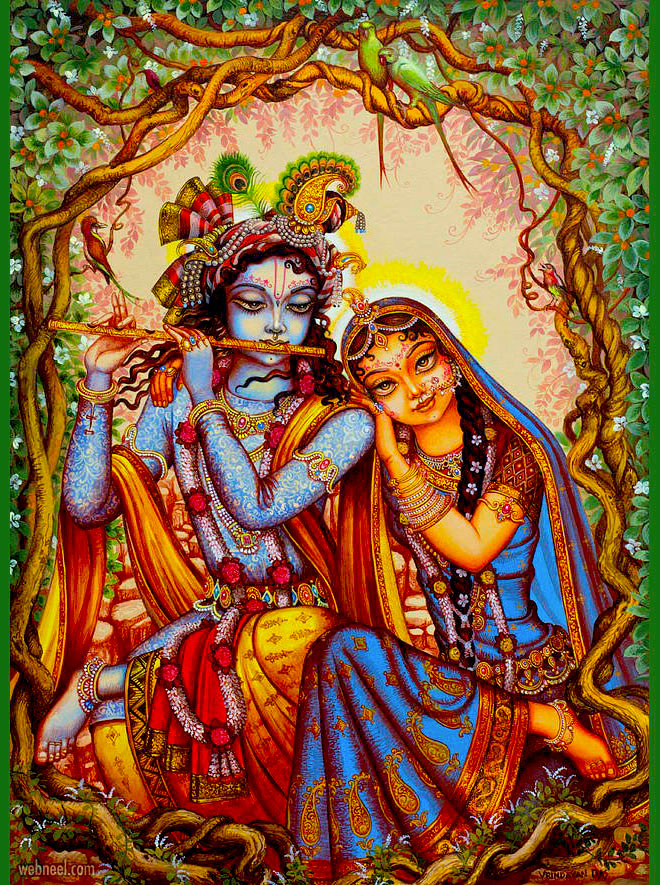Mahanidhi Madan Gopal Das
Srimad Bhagavatam is called the “king of all spiritual books” (Grantha Raja) for good reason. Within this triguna-free, transcendental treatise, the amala-purana, which showcases the absolutely selfless, divine love of Srimati Radharani, one can find all the sweet, majestic and beautiful truths about the sadhana and sadhya (daily practice and perfection) of Gaudiya Vaisnavism.
In his most compassionate and wonderful shastra, Sri Chaitanya Caritamrita, Sri Krishna Dasa Kaviraja summarizes the teachings of Sri Caitanya Mahaprabhu and the six Goswamis of Vrindavana by mentioning the same Bhagavatam verses that they used to substantiate their sublime instructions.
To emphasize the importance of these particular verses for all Gaudiya Vaisnavas, the same Bhagavatam verse is often mentioned two, three or more times in the Sri Chaitanya Caritamrta.
This series of posts presents these verses, along with selected tikas of our acharyas and the compiler. We will cover the beautiful truths, tattvas, of Krishna, Radha, Vaisnavas, Sri Guru, Bhakti Sadhana, Nama, Prema and more.
Where Does Bhakti Come From?
In Uddhava-gita, Sri Krishna answers this question saying:
yadrcchaya -mat-kathadau
jata-sraddhas -tu -yah -puman
na -nirvinno -nati-sakto
bhakti-yogo -’sya -siddhi-dah
If by unexpected association with devotees one develops faith in hearing hari-katha, such a person, who is neither completely detached from sense gratification nor too much attached to it, can attain perfection by practicing bhakti-yoga. (Srimad Bhagavatam 11.20.8)
Comments Mahanidhi Madan Gopal Das:
Some translate the word yadrcchaya as “by good fortune”. However, the dictionary meaning of yadrcchaya is “complete independence” or “freedom of will and action” and that is the meaning in this verse.
Sri Jiva Goswami tika:
The cause of bhakti is faith alone. That is explained in this verse. Faith arises from associating with devotees (yadrcchaya). The person develops faith in Krishna-katha and thinks, “This Krishna-katha is the best.” One then becomes disgusted with other activities.
However, one cannot give up objects of enjoyment which are the remnants of results of pious acts from previous lives even though one knows they give suffering. This person is not completely detached and not too attached. This is the devotee’s initial state. (Bhakti Sandarbha 171)
Visvanatha Cakravartipada tika:
A person develops faith (jata-shraddha) in Krishna-katha by the merciful association of devotees (yadrcchaya). That is the meaning of yadrcchaya in this verse. By the unexpected association of the devotee, even a person extremely attached to sense objects becomes qualified for bhakti.
The cause of a devotee’s mercy manifesting itself is bhakti itself residing within the devotee’s heart. Without the devotee having bhakti, there is no possibility of the devotee manifesting mercy to others. Bhakti causes the devotee’s mercy which causes bhakti in another person. Bhakti causes bhakti. The self-manifesting, causeless, independent nature of bhakti is thus concluded.
Pandit Sri Ananta Dasji Maharaja tika:
That bhakti manifests in an individual without any reason is the intent of this text. The word yadrcchaya, “by chance,” appears repeatedly in the Bhagavatam. Bhakti’s appearance in an individual does not depend on any external cause.
One may ask, if devotion is truly spiritual, then how can it manifest in a devotee’s material senses? The answer is that an iron bar put into fire attains the qualities of fire—brilliance, heat and the power to burn. So too bhakti, by its own potency, destroys the material nature of a person’s senses and spiritualizes them.
Shruti and Smriti describe bhakti as sac-cid-ananda-mayi just like Bhagavan Sri Krishna and as a self-manifesting aspect of Sri Krishna’s svarupa-shakti. It is only by the mercy of devotees that ordinary human beings can attain bhakti. As Krishna is under the control of His devotees, His mercy follows that of a devotee.
By carefully considering this point, one can understand that it is bhakti herself, residing in the heart of a devotee, that causes the devotee to give mercy to others. The conclusion is that bhakti alone is the cause of bhakti. Bhakti does not depend on any other cause for its appearance. Bhakti residing in a devotee’s heart, inspires one to act mercifully to others.
Krishna on the other hand is always absorbed in His own divine bliss and can therefore not feel the pain of the conditioned souls. Compassion arises only when one becomes aware of another’s misery. As Sri Krishna is the embodiment of concentrated bliss, it is impossible for even the omnipotent Krishna to truly feel pity for the bound jiva.
The only way the misery-bound souls can attain liberation is through the independent kindness of a Vaishnava. However, Vaishnavas also exist in the realm of bliss, but they can remember the miseries of their previous lives.
Sri Krishna has given full independence to His devotees to give blessings to others, and these blessings are the only way to reach Bhagavan Sri Krishna. The conclusion is that the jivas can only receive Krishna’s grace through the form of a devotee and not directly from Him. (Madhurya Kadambini tikas)
Comments Mahanidhi Madan Gopal Das:
Vaishnavas are the personified forms of Sri Krishna’s mercy, krpa-shakti-murtis. Vaishnavas have direct experience of the struggles, anxiety, tension, stress, frustration, pain and miseries of material existence.
And they themselves are the recipients of mercy, krpa-patras, from other kind-hearted, compassionate Vaishnavas. Thus, without the mercy of a Vaishnava no one can attain bhakti and the eternal loving service of Radha Govinda Yugal in Goloka Vrindavan!
Vaishnava krpa-shakti murtis ki jai! Jai Jai Sri Radhe!







